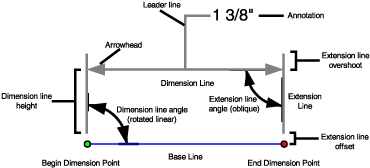NOTE: Although dimension classes can be both created and edited in ArcInfo and ArcEditor, they are read-only in ArcView.
ArcGIS supports two types of dimensions: aligned dimensions and linear dimensions. Aligned dimensions run parallel to the baseline and represent the true distance between the begin and end dimension points.

Unlike aligned dimensions, linear dimensions don't represent the true distance between the begin and end dimension points. Linear dimensions can be vertical, horizontal, or rotated. A vertical dimension's line represents the vertical distance between the begin and end dimension points. A horizontal linear dimension's line represents the horizontal distance between the begin and end dimension points. A rotated linear dimension is a dimension whose line is at some angle to the baseline and whose length represents the length of the dimension line, not the baseline.

All dimensions can be oriented either outward or inward. Outward dimensions have dimension lines pointing to the outside of the feature and represent the distance being measured between the two boundaries. Inward dimensions have arrows pointing in from the outside of the feature and measure the distance between these two arrows. Whether a dimension is outward or inward is determined by the distance that the dimension represents and whether that distance on the map is sufficient to display all the elements of the dimension between the extension lines.

You can create all these types of dimensions using a number of tools and construction methods available while editing in ArcMap.
Learn how to edit dimension features.
In the geodatabase, dimensions are stored in dimension feature classes. Like other feature classes in the geodatabase, all features in a dimension feature class have a geographic location and attributes and can either be inside or outside a feature dataset. Like annotation features, dimension features are graphic features, and their symbology is stored in the geodatabase.
A collection of dimension styles is associated with a dimension feature class. A dimension feature's style describes its symbology, what parts of it are drawn, and how it is drawn. Every time you create a new dimension feature, it is assigned a particular style. All dimension features of a particular style share certain characteristics, some of which can be changed on a feature-by-feature basis. Styles for a dimension feature class are created, copied, and managed using ArcCatalog. Using the editing capabilities in ArcMap, styles are then assigned to individual dimension features.
The following are the properties of a dimension feature that can be assigned based on a style:
| Dimension |
Properties |
| Dimension line symbol |
The symbol used for the dimension line. |
| Begin symbol |
The symbol used for the arrow at the end of the begin dimension line. |
| End symbol |
The symbol used for the arrow at the end of the end dimension line. |
| Begin dimension point |
The symbol used to mark the beginning of the baseline. |
| End dimension point |
The symbol used to mark the end of the baseline. |
| Dimension line display |
Indicates which dimension lines should be displayed: all, begin only, end only, or none. |
| Arrow display |
Indicates which begin and end symbols (arrows) should be displayed: begin only, end only, both, or neither. |
| Extension line symbol |
The symbol used for the extension line. |
| Extension line display |
Indicates which of the extension lines should be displayed: begin only, end only, both, or neither. |
| Offset |
The distance between the dimension point and the beginning of the dimension line. |
| Overshot |
The distance the extension line reaches beyond the dimension line. |
| Value to display for the text |
The actual string that is displayed for the dimension text. This can be the value of the dimension only (the length of the feature or a user-specified value); the value with a prefix, suffix, or both; or a custom expression. |
| Arrow fit and text fit |
The adjustment in the display of the arrows and text when the dimension's length is too short to show the arrows and text between the extension lines. |
ArcGIS provides tools that allow you to store dimensions in your geodatabase. You can also create dimension styles to apply to your dimension features so they are consistent with your application standards. ArcGIS supports a number of dimension types and methods for creating dimensions. Dimensions can be created automatically from features, or you can use the rich set of construction tools available in the ArcMap editing environment.
Once a style is created in a dimension class, it cannot be modified. If you want to modify the properties of an existing dimension style, you must create a new style with the new properties. You can create new styles based on the properties of an existing style, or you can import styles from dimension feature classes in other geodatabases.
Learn more about editing your geodatabase in ArcMap.
Dimensions are a type of geodatabase annotation. Like regular annotation, the information that dimension features convey is not useful unless you are zoomed in to a scale in which you can visualize the dimension features clearly. Like annotation features, dimension features are costly to retrieve from the database and draw on the map display. When working with dimension feature classes in ArcMap, you should always apply scale suppression so the dimension features only draw at scales in which they can be visualized.
Learn more about layers and scale suppression.








